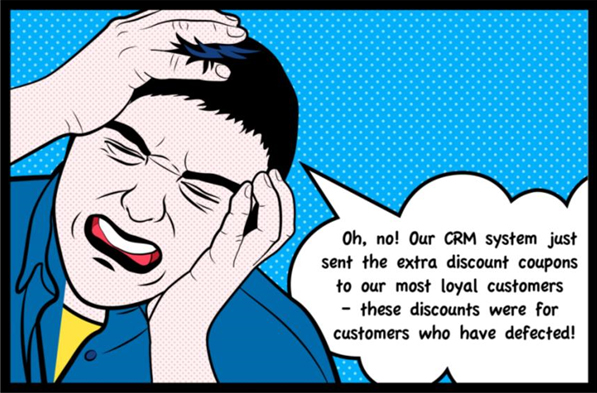CIO SURVIVAL GUIDE PART 3: MAINTAINING EXCELLENT CUSTOMER RELATIONSHIPS
B Ready For Relationships
BEING IN A RELATIONSHIP IS HARD WORK. THE INCREASING DEMANDS ON EVERYONE’S TIME MAKES IT DIFFICULT FOR PEOPLE TO INVEST IN RELATIONSHIPS. STRONG EMOTIONAL CONNECTIONS ONLY GROW THROUGH SHARING EXPERIENCES TOGETHER. THE CIO CAN DELIVER VALUE TO THE BOARDROOM BY ENSURING YOUR PEOPLE ARE ABLE TO HAVE MEANINGFUL RELATIONSHIPS WITH YOUR CUSTOMERS.
by Chris Parker
When was the last time you told a friend that you were going to implement a system to manage their friendship with you? It’s unlikely you would explain it this way to your friend. Although you probably already use various systems to make your friendship more meaningful. It is now normal to keep your contacts up-do-date on your computer, mobile phone or online so they are easily available. You are able to remember and act on every birthday and anniversary, which enables you to be a better friend. Companies often lose sight of why they use Customer Relationship Management (CRM) solutions. Too often staff sitting in an office start to view the customer as a task list or a complaint case to be resolved. While systems help capture and analyse information, the purpose should be to facilitate a meaningful relationship with your customers.
Personal relationships can be defined in various ways. A relationship can be a series of transactions, some forced connection such as in a family, an intimate sexual involvement or an emotional connection. Companies tend to focus on the transaction, often trying to force the customer into a relationship which they can’t easily escape and many times use sex in advertising to make the connection. The more challenging and more rewarding view on relationships is the establishment of an emotional connection between people – between your employees and your customers. People are able to create these types of connections when they have repeated interactions and are able to work towards a common goal like sharing a service experience or resolving a service failure.
When you are emotionally involved with another person, it is not unusual to ask for support and favours in times of need. During the worst of the economic crisis, Joie de Vivre hotels in California (www.jdvhotels.com) wrote letters to their loyal customers explaining that they were in deep trouble. They asked these people if they could share their positive feelings for the hotels with their personal network and ask if these people would be willing to choose Joie de Vivre when travelling in the area. It is only after establishing strong relationships with your customers that you can send out a call for help with the confidence it will be received positively.
A letter like Joie de Vivre wrote could have gone horribly wrong if the customers had never heard from your company before or if they didn’t have an emotional bond with your brand and your people. Even worse, the letters could have made people angry if they appeared to be generated from a CRM system instead of coming directly from the CEO himself. Joie de Vivre has their ‘Joy of Life Club’ for loyal customers, but that is not the reason why customers were willing to go out of their way to help the company in time of difficulty. It was because the people who work in the hotels authentically care about the people staying with them and the customers appreciate this.
The CIO has an important part to play in the customer relationship. The systems, processes and information must be available in order for people to have time to invest in relationships. If the common topic of discussion is about systems always being down, network failures or erroneous invoicing, it is unlikely people will have the time to become friends. Too often, organisations focus on winning back customers who have defected instead of investing in building strong relationships with customers who may wish to be friends with your company in the future. Do you spend more time trying to win back customers which have left or taking care of the customers who choose to have an ongoing relationship with you?
B Creative
Depending on how your company is positioning itself in the market, there are many creative ways the CIO can help connect your staff with your customers. A fun example is Barber Bart in New York City (www.barberbart.com). They have updated the traditional barber shop experience and made it more convenient for clients. One of the ways they have made it more convenient is having an online reservation system, so a customer can make an appointment on their own whenever they want and allows the staff to focus on building relationships instead of doing administrative tasks.
Barber Bart in New York makes it easier for their customers to have a relationship with them
Such a simple innovation is helpful to enhance the already existing relationship between a traditional barber and their customers. Customers of a barber already have a deep trust for that person. After the barber applies shaving foam with a brush, he proceeds to use a straight edge razor against the skin of their neck and face for a close shave. You don’t get much closer than that in a relationship and the online convenience just helps keep the customers to coming back.
B Happy
The Salon B chain of salons in the Netherlands (www.salonb.nl) is in a similar business as Barber Bart, however doesn’t have the intimacy of a shaving experience on which to build relationships. They have many issues which make it more complicated to build a lasting relationship with its customers, such as multiple locations, various staff working with customers, and a wide variety of service options. To create conditions for relationships to grow, Salon B creatively developed their business model, processes and systems to create a fantastic salon experience
The business model adopted by Salon B is not revolutionary and is the norm in other markets like the United States. Instead of hiring the stylists as employees, they enter into a relationship with contractors. These independent professionals make a commitment to the salon for a period of time and pay rent for the use of a station. The rent covers the overheads such as the location, the administrative staff, ongoing education opportunities and the supporting systems. This model creates an atmosphere where the stylists go out of their way to maintain the highest level of quality and are motivated to create lasting relationships with their customers.
The Salon B Creative Team of Andy Uffels, Ilham Mestour and Marriet Gakes maintain the philosophy of applying their experience from the back stage of catwalk fashion shows to the front stage of Salon B. They work to ensure the latest trends and techniques from the most famous of fashion brands and models are available for their salon customers. It is in Salon B’s interest to ensure their customers look fantastic and their independent stylists are successful.
Fundamental to the ongoing success of the salon and the stylists is the ongoing training. The training options cover topics you would expect such as styling techniques and product information. Salon B takes this a step further to provide training for their stylists in maintaining relationships. ‘Personal Marketing’ is a training where the stylists learn how to establish and maintain their personal brand and how to take advantage of the all the tools the salon provides them to connect with their customers.
The services provided by the salon are also beyond their traditional competition. In addition to the standard shampoo and cut, it is possible to have a half-hour head massage before the styling begins. After a wonderful massage during the shampoo process in a relaxing environment, a treatment which smells of fresh mint is applied and then a warm towel is placed on the head. This is an excellent way for customers to relax for a moment during their busy day. It is also very profitable for the salon as they can use support staff to give the massage. Salon B also uses this as a promotion occasionally by giving free head massages to returning customers, which generates more visitors for other services during cyclically slow periods. These types of promotions create value for the customer, traffic for the stylists, and keep the staff utilised during slower times.
Salon B uses the ‘Shortcuts’ (www.shortcuts.net) off-the-shelf software solution to record the contact details of the customer. It also tracks which stylist the customer has seen previously and their complete purchase history, which is helpful in case a customer has forgotten which styling product they purchased previously. Salon B takes advantage of the software’s capabilities by having a point system for loyal customers. For every Euro spent at the salon a customer earns points which are redeemable for products. After a few visits, the points quickly add up and the customer can choose a product for a nice discount or even free.
Salon B is not a low cost salon, however they are also not the most expensive. Located in city areas there is plenty of competition. Often their competition is literally across the road, yet they are able to maintain a higher than average rate for their services. Over the last few years during the economic crisis, when most salons have been struggling, Salon B has continued to grow and maintain profitability. While they aren’t doing anything revolutionary, they successfully bring it all together in a consistent and authentic way. They focus on creating the conditions for the customer to be happy, they work with the right people who enjoy building long-lasting relationships with people and have supporting processes and systems to make it all work seamlessly.
B Innovative
The consumer hospitality and beauty industries are based on human contact between people, so it is natural that they should have successful customer relationships. Other industries, in particular business-to-business, can also have winning strategies based on strong relationships. The more a CIO becomes aware of the marketing principles behind CRM, the more these CIO’s will be able to connect with commercial staff and relate to external vendors. The Marketing and Sales departments have measures and targets regarding customer satisfaction and loyalty. The more a CIO understands the motivation of these stakeholders, the more likely they will have a strong relationship. Technology vendors which are selling to businesses are aware that their products and services are hard to differentiate, which is why they invest heavily in events and other experiences for their customers to connect with their brands.
For any company, there are opportunities which the CIO can pursue regarding the business model, hiring practices and supporting processes. Are there additional services such as Salon B’s head massage which your company can deploy to utilise idle resources and create value for the customer? Is there any room in the margin to increase the unit cost slightly in order to provide specific discounts or other value later in the lifecycle of the customer? Do you hire the best people for the roles in the company which are most likely to build long-term relationships with your customers? These are all questions which can be investigated based on the insights a CIO has on the company’s information, processes and technology and can be implemented immediately in the functions the CIO is responsible for.
B Smart
The easiest way to discover the most efficient tool to maintain customer relationships is to go ask the most successful sales people in your company. They probably use elegantly simple solutions, probably based on pen and paper or standard software on their own computer. This is all you need to maintain contacts, however the person needs to be genuinely interested in investing in the relationships to keep it up to date. Keeping customer records current is hard work, and even harder if you are sharing this data across multiple functions. The CIO is the person to help the company manage their customer intelligence effectively.
Before you start implementing software solutions for CRM, make sure you are ready to invest in the relationships with your customers. An efficiency-led CIO strategy is now less valuable in the Boardroom than a strategy which ensures your staff is able to build meaningful and lasting relationships with your customers.
If your company hasn’t already invested in CRM on a large scale, then you may consider investigating some alternative solutions. Zoho CRM (www.zoho.com/crm/) is free for the first three users, which will allow you to start getting acquainted with the possibilities. SugarCRM (www.sugarcrm.com) has a Community Edition which is free to use, and they have a demo version of their enterprise product which is available free for a limited time. Now might be the time to benefit from the relationship with the software vendor you have been investing in all these years. I’m sure they will provide you with some free demo versions to allow you to test their solution against your ambitions.
B Ready
Any company can hire the right people and provide them the tools and processes to succeed. Any company can develop a brand position and value proposition which might be interesting for their customers. The difficult thing for companies is to allow the authentic personality of their people to show through all the processes and systems in a way that relationships can grow over time. A stylist at one of the salons summarised how it all comes together: “Salon B really makes sure there is a great atmosphere in the salon. The people I work with are nice and this creates a nice experience for my customers.”
The next CIO Survival Guide will explore how the CIO can improve your company’s performance in contributing to positive Employee Experiences.
Chris Parker ([email protected]) is a customer experience expert and helps business leaders around the world improve customer experiences by embracing emerging technologies.
The CIO’s Customer Relationship Survival Action List:
- Assess your current relationships against the companies you love to buy from.
- Enhance your business model, hiring practices and processes to support relationships.
- Hire or partner with a strategic marketing firm to help you plan your relationship strategy.
- Educate yourself and your team on the latest trends in CRM philosophy and solutions.
- Test the strength of your relationships by asking if your customers would help you in time of need.
- Make friends with your hair stylist and learn how they maintain customer relationships.
CRM Resources for the CIO
Managing Customer Relationships – A Strategic Framework by Don Peppers & Martha Rogers (2011)
Harvard Business Review on Customer Relationship Management (2001)
Zoho for Dummies by Steven Holzner (2009)
How to Create a Magical Relationship – The 3 Simple Ideas That Will Instantaneously Transform Your Love Life by Ariel and Shya Kane (2008)
Zero In On CRM HEROes: The Role Of Surveys, Observations, Analytics, And Engagement – Forrester Report by James G. Kobielus (2010)
Trends 2011: Customer Relationship Management – Forrester Report by William Band (2011)
Customer Think (www.customerthink.com)
Destination CRM (www.destinationcrm.com)
Successful CRM in a Connected World training (www.cim.co.uk/tandq/training/courses/0600.aspx)


